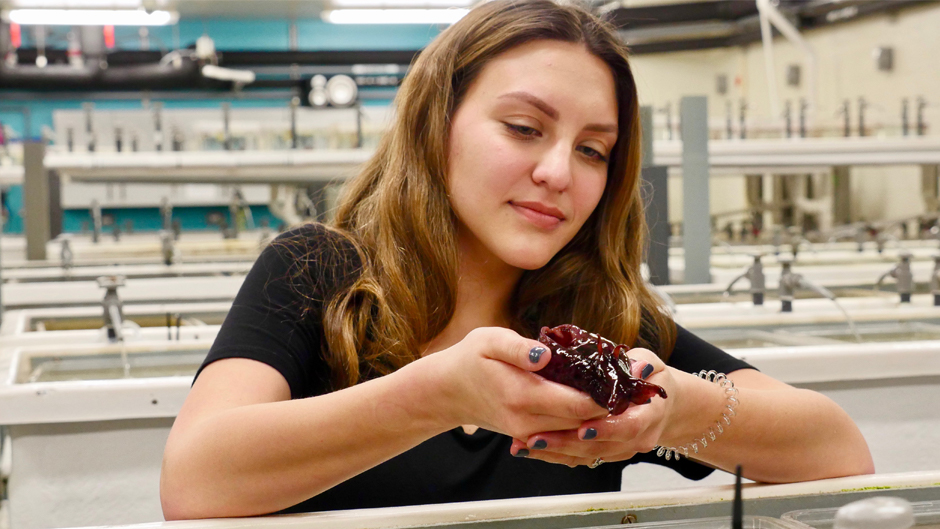When Becky Zlaktin entered the Bridge to the Baccalaureate as a Miami-Dade College student she hoped to gain some research experience. What she didn’t expect was that she would be the first author of a peer-reviewed research paper.
I didn’t realize until now how much of an opportunity I was given,” said Becky, now a senior at UM. “It was a great introduction into the life of a scientist.”
In 2017, Becky found an internship in the lab of Professor Martin Grosell at the UM Rosenstiel School where she met her mentor and soon-to-be coauthor Rachael Heuer, a postdoctoral researcher studying the behavioral effects of ocean acidification on marine organisms.
“I was very impressed when I first met Becky and knew she could handle a publishable project,” said Rachael.
With Rachael’s backing, Becky took the reins on planning and conducting an experiment using the California sea hare, known as Aplysia, to test the effects of high levels of CO2 in seawater on the nervous system of the slug.
Unlike fish, Aplysia have a simple nervous system and are often used as a model organism in biomedical studies on memory and aging. It was Becky and Rachael’s hope that Aplysia could also serve as a model to study behavioral responses to ocean acidification.
For this experiment, the sea hares were exposed to different levels of carbon dioxide in the water to study whether the change in ocean chemistry impaired certain behaviors such as their ability to reorient themselves after being released at the top of the water column, known as righting reflex, and how fast they relaxed after a tap on the tail, called the tail-withdrawal reflex.
Becky tested the animals’ righting and tail-withdrawal reflexes over a course of several weeks and drew their blood to analyze changes in its chemistry. Rachael set up the experiments so that Becky didn’t know which animals were exposed to high CO2 when she tested them. They did this to make sure Becky didn’t have a pre-determined idea as to how one group would perform over the other.
The results of the experiment, published in the journal, Royal Society Open Science, revealed that those animal’s exposed to high levels of carbon dioxide exhibited changes in certain behaviors like tail-withdrawal reflex.
The tail-withdrawal reflex was 37% faster in the CO2-exposed animals, which, according to the researchers, indicates that their predator reflex may be dimmed.
Becky, a ballet teacher in her spare time, credits this project and the Bridge program for directly leading her to pursue her undergraduate degree in exercise physiology.
“It really got me interested in research, which is the whole point of the Bridge program.”
Becky, excited to continue her science education, now has the firsthand knowledge of what goes into getting a paper published in a peer-reviewed journal and an experience that made a lasting impression.
The Bridge program between UM and Miami-Dade College was developed to encourage students from underrepresented groups to pursue PhDs and enter research careers in the biomedical sciences.

